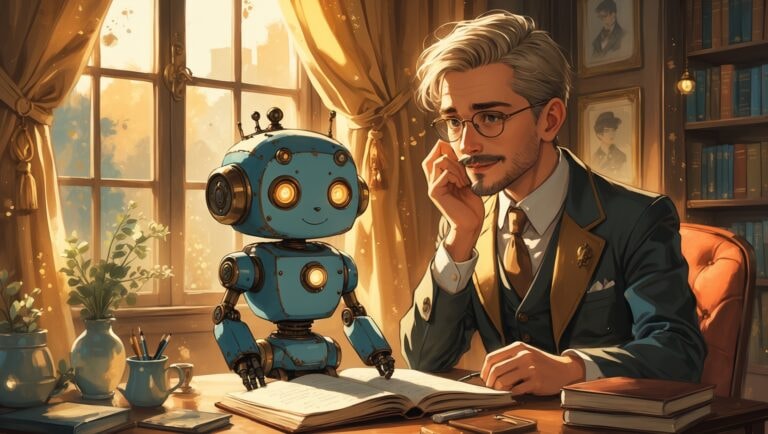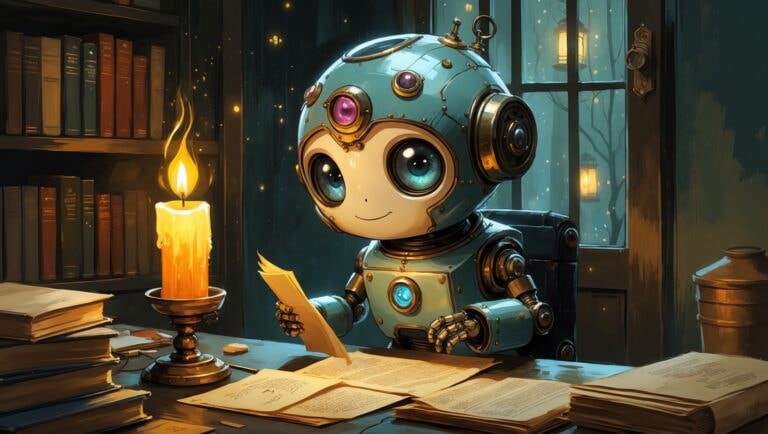
AI vs Human writing: Who Writes Better?
Every conversation about modern writing leads to the same question: can machines really write as well as people? That uncertainty didn’t exist five years ago. Now, AI writing tools can generate articles, emails, social media posts, and even seven alternative Harry Potter books in 1-2 minutes.
This shift transforms the previous question to who actually writes better? The answer is as complex as you could even imagine (if you don’t think so, keep reading). Both AI and human creativity have pros & cons, and understanding these will benefit you.
Disclaimer. The debate doesn’t have an objective of naming a winner. Because it’s impossible. Instead, we analyze what each type of writing does well, where it falls short. Or can AI replace writers?
Finally, how can humans and AI join forces?
What Is AI Writing and How It Works
Well, writing and AI is a tricky story. Let’s see why.
AI story writing uses machine learning to generate text. This is how tools like ChatGPT, Jasper, and Gemini work. They study millions of articles, books, and websites to learn language patterns. Literally, they predict.
When you give them a prompt, they give the most likely next words based on everything they’ve learned. Like a really smart autocomplete.
A problem: AI writing is limited by the data it has learned from. It can’t create ideas completely out of thin air, and it lacks personal experiences to inspire its words.
Human Writing: Strengths and Uniqueness
Human writers add something AI can’t replicate. We draw from our own experiences, emotions, and deep understanding of life.
At the same time, this is both good and bad news when comparing human vs AI writing.
AI can’t fully grasp context. Humans do.
On more strength: genuine creativity. We make unexpected connections, challenge assumptions, and sometimes create work that surprises even ourselves. This capacity for innovation that AI simply doesn’t have.
AI vs Human Writing: Key Differences
Tone and Style
Everyone who works with storytelling, marketing, and writing-related areas knows this feeling:
- too polished texts that are impersonal;
- no personal experience;
- cliches.
Get a combo of three? Congratulations, you see the AI output (bad one, actually).
To compare AI writing vs human writing, let’s take Terry Pratchett.
You can recognize his typical irony, clever metaphors, and unique words (so we need Wiki pages to know them all). For example, Death’s (from Hogfather) famous line, “Humans need fantasy to be human,” is the main idea.
What AI? Well, it can mimic different styles when prompted (for some tools, it’s tricky).
The differences between AI and human writing become obvious to anyone in longer and out-of-the-box pieces.
Emotionality
The gap between AI vs human writing examples is getting more apparent.
AI can describe emotions. It knows that “my heart sank” typically appears in sad contexts and “I was over the moon” shows up in happy ones.
But AI doesn’t feel anything. When it writes “I was devastated,” it’s selecting words based on patterns, not drawing from actual devastation. There’s no real emotion behind the text.
Human writers add their personal feelings to their work. Because those emotions shape the text comprehension.
AI text writing vs human writing for articles cannot compete in authenticity, which is hard to fake.
Creativity and Originality
This is one of the human vs AI writing characteristics that is hard to see at first glance. You need to read the whole result, or at least the big part.
AI generates content by recombining elements from its training data. It can produce fresh combinations and interesting juxtapositions, which look creative. But it’s not inventing truly new concepts.
How to differentiate between AI and human writing in reality? Let’s return to Terry Pratchett. The Discworld universe and the color octarine are completely original ideas that are difficult for AI to replicate.
Humans can break rules purposefully.
We experiment with form, invent new genres, and push boundaries in ways that training data can’t predict. We write things that have never existed before because we think in ways that pattern recognition can’t capture.
How to Tell AI Writing from Human Writing
Before we tell how to detect AI, let’s see why it matters (and for whom).
- Brands are chasing authenticity.
Companies like Nike and Duolingo have built their identities on genuine human (or owl) voice and connection. They believe authentic storytelling creates trust. Trust sells. The logic of AI and writing is simple.
There are even companies that refuse to use AI at all. For example, Heineken. They said that real friends are made over real beers, not through artificial companionship. Is this strategy a winning one? We will see in the future.
- Google’s algorithms are watching. Yes, like Big Brother.
Google doesn’t completely block AI-written content, but pages containing it can rank lower in search results. You can ask, Is it possible for the AI output to be unseen? Yes, but Google doesn’t need to know it.
- Readers can tell (and they care).
Audiences are becoming better at spotting AI patterns. That’s why you need to write by yourself or use AI wisely.
So, returning to our question, AI vs human writing—how to tell?
Detection Tools and Methods
There are as many AI detectors as there are text generation tools:
- GPTZero,
- Originality.ai,
- Scribbr
- QuillBot
- Grammarly
- Copyleaks
Paid or free, you choose. But the mechanism of their operation is identical: They look for repetitive sentence structures, predictable word choices, cliches.
They assign probability scores to show how likely it is that the AI created the piece.
The accuracy can vary a lot, though. The tools aren’t foolproof. They sometimes flag human writing as AI-generated, especially if that human writes in a formal, structured way. They also miss AI writing that’s been carefully edited by humans or generated using more advanced prompting techniques.
As AI models improve, detection becomes harder. The differences between human and AI writing styles are getting smaller with each new generation of language models. If you’re using fancy platforms like ChatGPT, Atlas, or Talefy, it’s pretty much impossible to spot AI.
Key Indicators in Texts
You can usually tell AI vs human content writing just by the way it reads, even without detection tools. As you see in the table:
|
Category |
AI Cliché / Example |
|
Overused openings |
“In today’s fast-paced world…” |
|
Empty transitions |
“This underscores the importance of…” |
|
Vague enthusiasm |
“Revolutionizing the industry” / “Game-changer” |
|
Same sentences |
“It’s not X, it’s Y/A/ A is not about, it’s about B.” |
|
Predictable structure |
“First, let’s discuss… Second, let’s explore…” |
|
Over-politeness |
“It’s important to note that…” |
|
Repetitive phrasing |
“Whether you’re a beginner or a professional…” |
|
Generic motivation |
“The possibilities are endless.” |
|
Buzzword overload |
“Leverage cutting-edge solutions to optimize workflows.” |
|
Perfectly balanced tone |
Never too emotional, never too bold. |
See any red flags? You can tell exactly where this story was written by a human or AI.
Some other signs to spot:
- AI avoids strong opinions or controversial statements unless specifically prompted. Human writers take sides, make bold claims, and sometimes say things that might offend some readers.
- Another indicator of AI writing vs human is the depth of specific knowledge. AI can write surface-level, but real experts bring nuance and insights. It could also be real examples from practice.
Will AI Replace Writers?
Yes, but not completely. We believe in this answer. Why?
AI excels at certain types of writing. Product descriptions, basic news summaries, simple how-to guides, and straightforward informational content can often be handled well by AI. For these fields of AI vs human writing comparison, the first one is faster, cheaper, and often good enough.
But AI can’t take the place of human writers when the work calls for real creativity, deep knowledge, or emotional depth.
Some writing jobs will definitely change or disappear. Content farms that produce generic articles at scale might rely more heavily on AI. Simple copywriting tasks might become automated. But work that requires a human touch will still need human writers.
AI and the Future of Writing
When it comes to wholesale replacement, transformation is more likely.
AI can take care of tasks you find robotic. For straightforward, informational content, it’s honestly pretty good. Writers who use artificial intelligence as a resource are likely to achieve greater success than those who avoid it entirely. Right now, about 45% of writers use AI as an assistant to help them with their work. The further, the better.
How Humans and AI Can Work Together?
The best approach could sound like “AI-generated content vs human writing accuracy.” We love so much more “Ways how AI and humans can work together.” Let’s see how writers can use AI:
- Speed up the drafting process.
- Generate an outline.
- Get past writer’s block.
- Use like research assistance. You still need to verify facts, but AI can accelerate the gathering phase.
- Create a first draft to revise.
- Brainstorm multiple approaches to a topic.
- Catch grammar errors, suggest alternative phrasings.
The key is understanding what to delegate. AI writing style vs human writing style should be in their places.
Let AI handle the boring stuff as repetitive tasks and first drafts. Save the creative choices, big-picture thinking, and final touches for yourself.
Who Writes Better?
The question “who writes better” assumes there’s a single standard for quality. In reality, better depends entirely on which human writing characteristics vs AI writing you need.
- For speed, AI wins easily. It can generate thousands of words in minutes without breaks or complaints.
- For consistency across large volumes of content, AI also has advantages. It doesn’t have off days or get tired.
- For emotional depth, humans win decisively.
- For most practical writing tasks, the answer is probably “both, working together, AI and writers.” This collaboration produces better results faster than either could achieve alone.
So, stop choosing sides in the human writing vs AI writing battle. Readers only benefit when we use every available tool to create clearer, more engaging, more thoughtful content.



